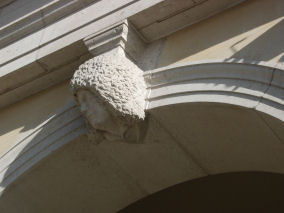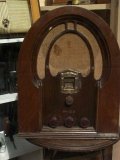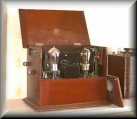Noise - beware of too much 'glare' in the sound picture!
The problem of thunder and lightning (and of surf.... ) (BELOW)
|
There is a danger that if you get the balance wrong between the sound categories in a scene. The resulting mix could be a mess. Why? |
| Note - these are the different categories of sound in a radio drama scene: the vocal, sound effects, atmoses or different conditions of ambience, music, noises from nonsentient objects, silences. |
Your scene is too noisy! Too much 'glare' in the sound picture!
| WHY? You have too much going on. You have to go back to basics. Do you require standard production for this scene? |
| Do you need to reduce the number of sound effects (SFXs)? |
| Do you need to reduce the atmos (background) further beneath the dialogue? |
|
Poorly chosen ATMOS with peaky sound events. These fight against the dialogue. |
| ATMOS - AVOID LOGIC PROBLEMS |
|
OVEREXPOSURE IF THIS WAS VISUAL: Think of the noise problem like this. If this was the visual track of a film, you have got overexposure in your scene or areas of overexposure. |
|
'CLIPPING' You could also continue to think of this as - in video. This is what is called 'clipping' - where bright images turn to white. |
| Think of this from the science of acoustics. You could have 'pink noise'. Equal amounts of energy are being pushed out in each of the different categories of sound in your radio drama scene. You have to rebalance. |
| Thunder seems to import only one meaning from the Lifeworld into the fictional world of the scene. It is like a hammer blow. It is a sound event of such intensity, duration and bass pitch. |
| It just does not seem to allow multiple meanings and nuances for the listener. |
|
True- thunder is used a lot in the cinema sound-track - and that is the problem! In Dolby surround-sound, it makes its impact - physically - on our bodies. THIS IS WHY. But thunder is too immense for the intimacy of radio. |
|
Thunder has a 'wall-papering' result - it 'plasters' its pre-conceived meaning on the narrative action, without regard to what the dialogue and situation may contain. |
| It is a sound event in the 'outer frame'. It suddenly widens out the sound picture to the furthest distance. Do you want to do this? Does it serve the narrative? |
| Any director can argue for its use. The final decision is with the director, after all. |
| GENRE: Is the scene in the horror genre? Vampires are around? Thunder is the trademark - so OK! Use it! |
| There is a reference to thunder in the script. There is description (my technical term). Fine! |
|
ARTISTIC PROBLEM OVERALL: But the real problem is an artistic one. Thunder is a hammer blow (or at least it was in mythology). But radio drama is, for the most part, a miniaturist art. You need to work on the dialogue, acting and post-production with precision tools. You want to create the feeling of unease in the audience? You want to suggest that bad things are around the corner? You need to work on the actors, and to edge in those feelings in the audience. You need to use a symbol system, finding those (true) hidden meanings, opening up mindful and emotional qualities for the listeners. We appreciate it when a film director uses a symbol in this way, as smoke, fire, a flower etc. Now find those qualities in your radio productions. OTHER SOLUTIONS: Perhaps some under-scoring music? Or a soundscape which is anxiety-inducing - and using other sound events? What about putting that scene on the balcony of an apartment? - and we can hear in the distance the barking of guard dogs, some disturbance in the streets far below (drunken singing, smashing of glass, a chase), emergency vehicles, football crowd coming away from the match. There are lots more edgy sound events, and combinations that you can think of. You are now working as a sound artist. You now allow the listeners to respond actively to what you offer - selecting and rejecting from their own mental baggage and associations. You reject a sound effect - thunder - that has only one widely-held assumption. You work against a usual habit of response to thunder, and common-sense belief about thunder. You create a tighter sound picture - a more emotional one, closer to the life of the characters. DEFINITIONS Standard production
(term coined by AB): A type of noise with equal energy in each octave vs white noise which has its energy distributed throughout the frequency range of audio. Pink noise more closely approximates the frequency/energy distribution of conventional music. |
CONTINUING THROUGH THE SITE:
|
|
||
|
|
|
|
|
|
|
|
|
|
'moving camera' technique | |
|
|
|
'Will you turn that music down!' |
| drop-ins | sound pictures |
|
| number the scenes carefully with a system | voice in the mind = interiorizing |
|

|
|
Any opinions expressed in this site are the personal opinions of the owner of the site. IF YOU HAVE COMMENTS, PLEASE EMAIL TO : [email protected]



